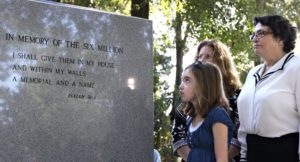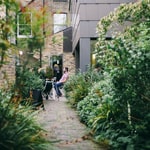Gainesville

JUdaism in Florida
Jewish people are among the earliest European settlers in Florida as many people embarked for the Americas to escape persecution during the Inquisition. The historic Jewish cemetery in Gainesville is the oldest stand-alone Jewish cemetery in the state with the first burial of 20-year-old Abraham Pinkussohn in 1871. In 1946 the cemetery was transferred to the care of the B’nai Israel Congregation. It contains Gainesville’s only Holocaust Memorial, which was installed in 2010.

Reflection
The cemetery is less than a mile from my house, so I decided to ride my bike in the middle of a hot Florida July day. The cemetery is situated on the corner of a relatively busy intersection in the eastern portion of Gainesville. The east-west divide in Gainesville has received significant attention in recent years in light of uneven development which some have blamed on the University of Florida. The predominantly white western portion of Gainesville is more affluent with a wide range of amenities, infrastructure and aesthetic maintenance by the city. The predominantly African-American eastern portion of city represents the poorest neighborhoods, aging infrastructure, and dilapidation.
As I approached the cemetery at the busy intersection of Waldo and East University Avenue, I was solicited by three members of the homeless community set up on the medians. It was hot and noisy with traffic. The sidewalks were cracked, the grass in the medians was overgrown, and food containers from the corner gas station littered the street.
The cemetery is surrounded with a wall and gates. Inside the garden and tombstones stood in contrast to the hustle and bustle at the intersection; the flowers and grass landscape and the stillness of stone gave a somber atmosphere to the concrete and exhaust outside the walls. Initially the cemetery seemed out of place; a Jewish space in a predominantly African-American neighborhood. It seemed like a relic from the past that managed to persist in the face of changing modernity.
When I encountered the holocaust memorial, however, my reading changed. Small stones perched on the memorial reflected a tradition that connects the Jewish community throughout the world. The memorial compelled me to reflect on the six million lives exterminated during the holocaust and those who suffered in concentration camps, and this reminded me of the millions of Africans who died and suffered through enslavement. I reflected on the long history of persecution of Jewish people; the Jewish ghettos that segregated the population from larger European society and the marginalization that existed throughout Europe for centuries before Hitler. The Inquisition forced Jewish people to flee Europe and settle in the Americas at the same time Europeans forced enslaved Africans to leave their homes. The holocaust memorial connected two pasts to the present, and the parallels between the Jewish-American and African-American experiences became more evident than the superficial sensory contrasts between the cemetery and the space surrounding it.

Image Gallery
Judaism Past and Present Contexts







Contact Us
To arrange a visit , contact B’nai Israel Congregation
pending permission from B’nai Israel congregation
pending permission from B’nai Israel congregation
pending permission from B’nai Israel congregation